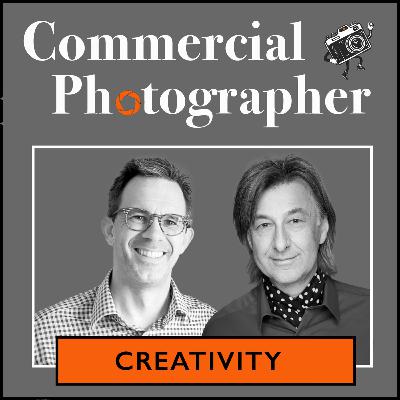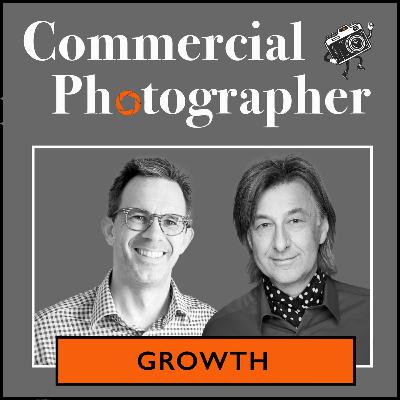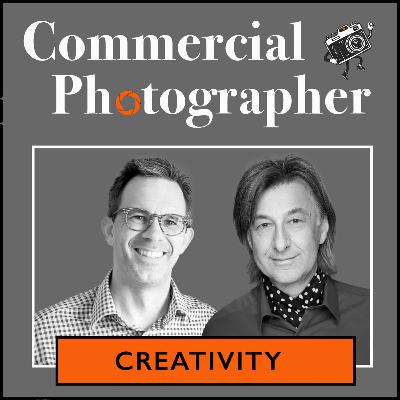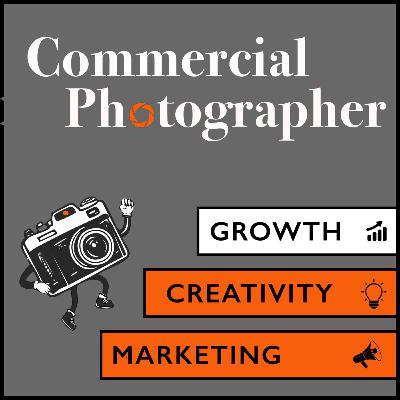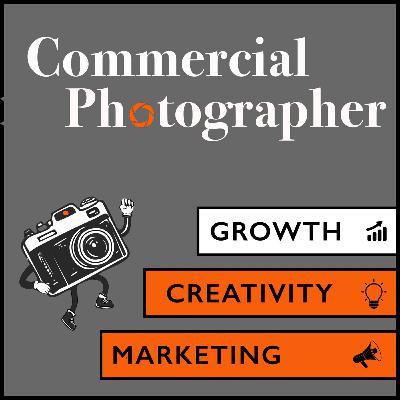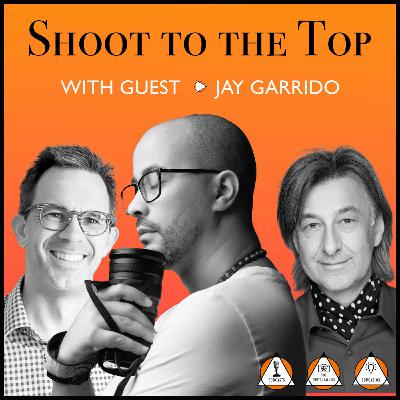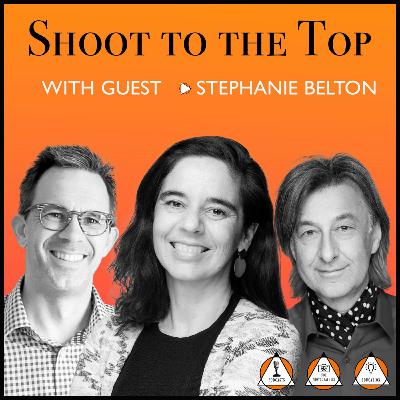Discover Commercial Photographer: Your Guide to Marketing, Creativity and Growth
Commercial Photographer: Your Guide to Marketing, Creativity and Growth

Commercial Photographer: Your Guide to Marketing, Creativity and Growth
Author: Sam Hollis and Marcus Ahmad
Subscribed: 7Played: 113Subscribe
Share
© Sam Hollis and Marcus Ahmad
Description
Commercial Photographer: Your Guide to Marketing, Creativity and Growth is the essential podcast for professional headshot and brand photographers. Ready to achieve sustainable business growth? Each week, we share practical advice and actionable strategies to help you master your marketing, ignite your creativity, and build a profitable photography business. Learn how to attract ideal clients, stand out in the marketplace, and build the business you've always wanted. Stop guessing and start growing with business help and guidance from a community of industry experts.
138 Episodes
Reverse
This week Marcus and Sam discuss the use of black and white photography.
Marcus did a poll on LinkedIn and found that (from the sample of people who responded) people preferred colour for a head shot, but like black and white photography in their homes.
William Eggleston a famous photographer did an exhibition in
the Museum of modern art, New York in the mid 1970s and he used colour. At the time the critics said his use of colour was “vulgar”.
Marcus thinks that using actual film, black and white film, and developing it yourself will expand your understanding of black and white photography. Now the software we use for photography still uses many of the terms that come from those original dark room techniques. And they will make more sense once you have experienced developing actual film. There are photography clubs all over the country that have dark rooms you will be able to use.
Marcus also think photography books are also a great way to learn about black and white photography. Also go and look at photographic
exhibitions and how those photographers use black and white photography.
Sam and Marcus then talk about the use of black and white
commercially. Black and white is great for headshots. Also, for some businesses black and white can really match their brand. Some brands need some bright colours, but for others black and white can work really well for their brand. Barbara Kruger is a famous photographer who used
red text against black and white photography which was a great look and could work really well for a brand.
At weddings black and white can be used. It’s used often when the weather is bad as it helps deal with poor light. But black and white can also be used for effect on any wedding. But as the shots will be digital these can be made black and white after the event.
Don’t forget to sign up to the podcast newsletter to get the lastest episodes direct to your inbox, get bonus extra content past episodes to try and more.
The Challenge: Every Commercial Photography session starts with a client saying, "I hate having my photograph taken." The Solution: Expert listener Colin Smith reveals the Commercial Photography Skills that help you immediately build trust, relax your subject, and capture authentic emotion.• The 10-Minute Mindset: Discover the specific psychological framework you must adopt upon arrival to master Photographer Rapport Building even before you pick up the camera.• The Golden Prompt: Learn the single, magic sentence you can use while shooting that shifts the client’s focus and unlocks genuine expression for the perfect photo.• The Inner Practice: Find out the counterintuitive 10-minute listening exercise you can practice at home to instantly improve your essential Commercial Photography Skills.
Is your Commercial photography income seasonal? Wedding photographer Nick Church reveals the reality—and huge potential—of offering Photography education. Learn how this strategic service can be the ultimate tool for Photography business growth.• The Passive Income Lie: Find out why the promise of automated recurring income is false, and what level of sustained marketing work is actually required to make your course profitable.• The Conversion Secret: Discover the specific type of marketing content that attracts genuine buyers, and why high-spend generic ads fail to generate high-quality leads for your Commercial photography business.• The Overlap Advantage: Learn the simple branding trick that turns your existing Commercial photography clients and network into your warmest, most valuable source of education leads.
Are you leaving money on the table? Marcus breaks down event photography, a high value, high pressure genre that perfectly complements your commercial photography marketing. Learn how to capture the atmosphere and emotion that brands need for their future campaigns.• The Preparation Blueprint: Discover the essential questions you must ask your client before the day begins to guarantee you capture the client's full vision.• The Gear Guarantee: Discover the essential equipment setup you must adopt to guarantee reliability and professional results in unpredictable, low light venues.• The Relationship Advantage: Learn the powerful, simple strategy borrowed from wedding experts that helps you turn venues and speakers into your best source of repeat bookings.
Is your SEO still working? This episode with web expert Alex Vita asks the provocative question: Is traditional SEO dead in the age of AI? Discover why tracking website traffic is no longer enough and what strategic shift you must make to secure premium clients in the "Zero Click Marketing" world.The Zero Click Strategy: Discover why chasing simple SEO traffic is a waste of time and what single metric you should be tracking instead to prove your online efforts are working.The New Rules of Google: Learn the most crucial concept for modern SEO and Google Search, and how to build a powerful online reputation that satisfies both AI and your potential clients.Positioning for Premium Fees: Find out how to stop being a generalist and use a simple positioning tactic on your website that allows you to immediately justify charging higher fees.
Discover the true numbers behind the industry's gender split and see exactly why brand photography is attracting so many women photographers right now—and why it’s not just a coincidence.Uncover the 'magic ingredient' of successful brand photography that allows you to charge more, secure repeat business, and turn simple images into powerful brand stories for your clients.Identify a huge commercial advantage that many photographers are currently missing, which represents a clear path to high-value, consistent bookings if you understand how to approach it.This week, we're diving into a topic not often discussed in the photography world: why brand photography is so heavily dominated by women photographers, both behind the lens and as clients. We go beyond the gear and business strategy to look at the psychology and personal connections that truly drive success in this niche.Marcus and Sam discuss the surprising statistics showing the gender ratio and break down what makes women excel in this area—it's less about technical skill and more about empathy, storytelling, and emotional intelligence.But here's the kicker: The show uncovers a huge commercial opportunity. We discuss an untapped segment of the market and what you need to know about their distinct visual approach. If you’re a brand photographer looking to increase your income, stand out from the crowd, and secure more repeat clients, tune in to find out where the real money is and how to get it.
Marcus is back this week with a fantastic guest: Colin Jones, CEO of The Society of Photographers (The Societies).In this powerful episode, Marcus and Colin dive deep into the state of the professional photography industry, focusing heavily on the commercial and B2B sectors. Colin shares critical insights on how a 5,000-member international organisation supports photographers and what it truly takes to succeed in today's demanding market.What You Will Learn. We’re covering the three key takeaways you need to navigate the evolving industry:How to significantly improve your photography and build a more profitable, premium business by leveraging the support, mentoring, and community of a dedicated professional body.How the commercial photography market is changing, addressing the challenges and opportunities presented by AI, and exploring which specialised markets (like food, architecture, and product photography) are thriving.Why ideas are the gold standard of your business, and why technical excellence alone won't cut it in the future, especially as technology advances.
If you're looking to accelerate your journey in Brand Photography or Growing a photography business, this episode is an absolute must-listen. Sam and Marcus dive straight into the practical, down-to-earth steps for finalising the purchase of a photography business, focusing on the client lists and assets that form the real value. Stop wondering how to get ahead and start implementing the strategies that will give you significantbenefits and set you apart in Marketing for photographers.What You'll Take Away From This EpisodeWant to know the secrets to a smooth and profitable acquisition without getting bogged down in solicitor fees? Listen in todiscover:The straightforward process for drawing up a watertight contract. You'll learn why you can ditch the expensive lawyers and what simple, clear language is vital to make sure all parties stick to the agreement.The non-negotiable next steps to monetise your new client list immediately. We show you how to be proactive and make a plan to gain maximum value from the assets you've just bought before they go cold.A clever negotiation tactic involving staggered payments and commission. Hear how to structure a deal that reduces your risk and incentivises the seller to help you transition clients, all while keeping the cash flowing.
Tired of the slow crawl to grow your photography business?In this episode, we're talking about a serious shortcut: buying an existing outfit. Sam shares his personal experience and lays out a practical guide on how to acquire a local photographer's assets to instantly boost your client list and portfolio, including a deeper dive into lucrative commercial photography and brand photography markets.What You'll Take AwayInstantly scale your business overnight: Discover the one radical move that can double your client roster and digital presence without years of grafting.Avoid the biggest financial mistake: Learn the critical difference between buying the 'business' and buying the 'assets' to protect yourself from hidden debt and legal faff.Work out exactly what you should pay: We give you the no nonsense methods for valuing a business's goodwill and client list, including clever ways to structure payments that protect your cash.Ready to stop waiting for growth and start making it happen?This episode is packed with invaluable, practical advice for any UK photographer looking to get ahead.
Brand photography isn't just a job; it's a goldmine for creativity and a sure-fire way to deliver massive value to your clients. Aimed squarely at UK photographers, this episode cuts through the waffle to show you how a fresh approach to branding shoots can keep you creatively sharp and significantly move the needle for your business.Stop leaving money and opportunities on the table. Here's a taste of what you'll gain from listening:You'll discover the simple yet powerful shift in focus that instantly transforms your images from simple snaps into authentic, powerful visual narratives for your clients' brands.How do you stay razor-sharp creatively when working on multiple, varied projects? We reveal why shooting brand photography forces you to borrow from different photographic genres, and how this fusion keeps your skills fresh and your portfolio unique.Learn the crucial difference between 'spontaneity' and poor planning, so you can walk onto a set fully prepared while remaining completely open to unexpected, brilliant ideas—a skill that impresses clients and leads to your best work.
Tired of throwing time and money at marketing and gettingnowhere? This week, Sam delivers five and a half practical, low cost marketing strategies for photographers that any UK photographer can implement right now to bring in higher paying commercial photography clients and grow theirbusiness.This episode is packed with useful content, but we've pulledout the three essential takeaways that will most quickly boost your commercial photography business. Stop relying on luck; start implementing a clear plan that converts prospects into paying customers.Listen to discover:Three Things You’ll Learn in This EpisodeThe Hidden Database on Your Hard Drive: Discover the simple, overlooked source of paying clients you already possess, and learn the UK-specific GDPR rule that allows you to contact them immediately, turning old inquiries into new sales.How to Break the Ice with Big Decision-Makers: Find out the essential 3-step blueprint for warming up leads on LinkedIn before you send a connection request, ensuring that key marketing staff are ready to see the value in your commercial photography.The Low-Cost Client Funnel You Need: Master the technique of the "discounted offer" (like a simple headshot) and, more importantly, the crucial plan to successfully move those first-time buyers onto your premium, high-value brand shoots.Grab a cuppa and listen now—your next big client is waiting.
This week, we're joined by personal branding experts Kaz Grant and headshot photographer Toby Lee. Toby has built an excellent personal brand which has helped him to stand out from the crowd and attract new customers. They discuss how all photographers can use their personal brand to grow their business. We explore why your reputation is more important than ever and how you can leverage it to get more work. Tune in to discover why a strong personal brand is the key to standing out in a crowded market.What You’ll Learn From This Episode:Discover the secrets to building a personal brand. You'll learn what a personal brand actually is and how it can help you get ahead in your photography business.Find out how to attract new customers. We reveal how to make your social media and video content work for you by turning a passive audience into active clients. We also discuss other key marketing channels.Learn how to make personal branding an enjoyable process. We give you practical tips for creating a personal branding strategy that feels authentic and fun, so you can do it consistently and see the benefits.
Tired of feeling like you need to remortgage your house to buy quality photography equipment? Think again. In this episode, we reveal five game-changing items you can get for under £20 to significantly improve your skills and efficiency in commercial photography. From must-have gear to mind-altering concepts, we give you the tools and ideas to elevate your work without breaking the bank.What you'll learn1. Low-cost gear that transforms your shots: Discover two affordable and essential pieces of photography equipment that will drastically improve how you manage light and capture stunning images, whether you're working with natural light or studio flash.2. How to see your work with fresh eyes: Learn about two influential books that will change the way you think about your commercial photography and help you develop a deeper understanding of your craft, turning you into a more intentional and creative photographer.3. The one small investment that could save your shoot: Find out about a simple solution that allows you to see your shots in a whole new way, helping you make real-time adjustments and impress clients with a professional workflow.
Struggling to protect your work and get more clients? In this episode, we chat with award winning travel photographer Nico Trinkhouse who shares his experiences turning a negative situation into a positive business venture.Three Things You'll Learn• How his personal journey with copyright led to a new business and a proven way for photographers to get paid when their images are used illegally.• Why his unconventional approach to blogging has become his most effective marketing tool for finding and winning high value clients.• How he discovered a business model that is far more profitable than the
Want to get more photography clients through the door? This week, we're talking about how to turn Google Maps and Google Business into powerful tools for getting more leads and growing your business growth. Learn how to improve your local marketing and get found by the right people, all without spending a penny.In this episode, you’ll learn:Why the name you've chosen for your photography business could be holding you back and what you can do about it to get more leads.The one thing you must do to get to the top of Google Maps and why reviews are absolutely vital for your marketing.How to craft your Google Business profile to get more clients, and why you should be posting on it regularly.
Marcus says that Flash used to be challenging many years ago. But now life is much simpler. Sam asks about Chinese copy brands, but Marcus says that with modern lighting, the Chinese equipment isn’t a copy; they are the originators. Marcus is going to be talking about Godox lighting, which is sometimes known by a couple of other brand names. He is going to give anideal kit to have with you. Marcus says you want your lighting all to be the same brand; otherwise, your lights will not communicate with each other, so this is essential. A handheld or on-camera mounted flash is what we are goingto talk about first. Sam digs out one of these from his cupboard. Marcus says these simple flashes are great and often five times cheaper than the camera brand flashes. Godox’s camera flash is called the V1. This is the basic start, and it goes onto the hot shoe of your camera. The next level up is to get aremote that goes onto your hot shoe. That allows you to put your flash where you want; it is no longer tied to the camera. Once you have a remote, all other flashes need to be the same brand to communicate with the remote. The next thing needed is a main light. Marcus recommends that if you get one, then a Godox pro light, which is near the top of the range, is worth getting. The flash head is very large on the Godox pro range, which Marcus likes. The flash head is also diffuse, and the glass is diffuse, not clear. Marcus also says he recommends going for a high-power flash. The main reason is that the batteries are so good and have almost no time to recharge between shots. Marcus also says that some of these lights can also separate the light and battery, so the lighter light can be on a stand without the battery being on the stand too. Finally, Marcus talks about a modifier. A modifier goes onto the light to modify it. Marcus says the best modifier to get is an umbrella. Marcus doesn’t recommend the Godox umbrella.He recommends going for a more expensive umbrella. He says they last longer, and reflective material is better. He recommends getting an umbrella that is at least 1 metre across. There is also an alternative to an umbrella, which Marcus describes.To get the Shoot to the Top Podcast in your inbox every week, click here And to join the Shoot to the Top Facebook group here.
Jay Garrido is a Mozambican photographer. He studied film inCape Town. However, the film industry in Mozambique is not very developed, so he turned to photography. He started with weddings but transitioned to magazine work and now wants to return to his creative roots. While in Cape Town, there was a diverse mix of people from various cultures. Marcus asks about photography in Africa. Jay talks about photographer Mario Macilau. He grew up in a poor neighbourhood. By chance, he got his hands on a camera that was donated to him because his photos were so good. He is now a top photographer. Jay says there is a lot of culture to present through photography. He says the market is growing exponentially. There is a school of photography in Cape Town where lots of experimental photography and he got to see lots of their work while in Cape Town.Jay says the commercial market in Mozambique is also growing. He had an opportunity to work with a high-level Portuguese magazine. He felt working with them forced him to level up his work. After that, he worked with Indico for 5years, which is the magazine of the Mozambican airline. This meant he didn’t just work for the magazine but also with the businesses advertising in the magazine. This helped him move into commercial photography. He says the commercial market is growing rapidly, as it is in many other African countrieslike Angola and Nigeria. Jay is sure that good photographers coming to Mozambique with their style would make a lot of money. Jay says that the photographers who do their own look are well ahead of everyone else and can pick who they work with. Jay has also worked for agencies here in Mozambique, both in photography and video work. He wants to eventually become a director of photography once the film industry starts to develop. He has managed to spend time shadowing a Portuguese director of photography. Jay has got a lot of work from word of mouth. His work with the magazine meant he met a lot of people in business. He has also found that wedding work has led to commercial work due to the people he has met at the weddings, who liked his work. Jay and Marcus also discuss weddings in Mozambique. Mozambique has some stunning beaches and five-star resorts, which are amazing for weddings. Marcus likes the sound of Mozambique and wonders if he should move out to join Jay and Sam. The podcast is now on YouTube, and you can see our YouTube channel here. You can reach out to Jay on Instagram hereTo get the Shoot to the Top Podcast in your inbox every week, click here And to join the Shoot to the Top Facebook group here.
Are you a commercial photographer who undervalues the headshot? 30 year veteran Nick Gregan explains why a single portrait holds the power to make or break a career. Learn why specialisation, confidence, andconnection are the keys to premium headshot photography and effective marketing for photographers.• The Career Catalyst: Discover why a powerful photograph carries the potential to launch a career, and the heavy consequences for your clients if you approach their headshot photography without expertise.• The Two Techniques: Learn Nick's unique system for building instant client rapport and capturing authentic personality, a crucial skill for successful marketing for photographers.• The Artisan Model: Find out why Nick moved away from high volume, low cost work, and how adopting an "artisan" model allowed him to increase his rates and transform his business significantly.Get the Commercial Photographer Guide to marketing and Creativity here.
Stefanie has been a professional photographers for twenty years in the St.Albans area. Her focus is now 100% on commercial photography. Stefanie says it’s important to think about what motivates people to get photos. What are the triggers that make people want a photograph? This could be an event for a family, it could be being asked for a headshot as a business leader. Stefanie says it’s very important to make it very easy for people to work with you. For example if someone wants a corporate headshot she already has a blog ready that answers many of the questions they might ask about headshots. A few weeks ago Stefanie was working with a school on their marketing. She said the women at the school was convinced that she only did school photography as she had such a great landing page for school photography. Having specialised landing pages for areas you work in makes life simple for the lead which helps to convert them. Stefanie also ensures she responds to lead very quickly.Stefanie also wants to engage the local community as she wants to work locally. For example last year she went on a local Mum’s Facebook group and said she wanted to help those with a LinkedIn profile photo that they were embarrassed about. She offered a free headshot for three people who were happy with their before and after shots being shared publicly. She got a lot of queries and then worked out who she wanted to work with using various criteria, including making sure they were very different. So the posts on the Facebook group created abuzz. She then started sharing what she did on LinkedIn. She did some posts asking people to help people choose their new headshot and gave a few options. This got lots of engagement as so many people saw the post and so many people were willing to chip and and comment on which headshot should be used. This process has also been working on the triggers helping people realise they do need a headshot. Corporate photography UK is a Facebook group that Stephanie helps to run along with Martin Hobby (see our show with Martin here). Elise Marks setup the group. The group is about supporting each other and is Uk based. The group is also used for referrals, so for example if Stefanie does a photoshoot in London and the same company needs a photoshoot in Manchester, she would use the group to find someone to refer that work to. Stefanie says it’s vital that your website is excellent as it needs to appeal to photographers looking to refer work. Also she says she won’t refer work to photographers who don’t have a good website, even if she knows they are excellent, as she wants to ensure the person she is referring gets the right impression.Marcus asks about Stefanie’s use of artificial light. She says she uses artificial light nearly all the time. As she is a portrait photographer then light on the face needs to be right and an artificial light is essential for this. Stefanie’s advice for anyone moving to corporate photography is first of all to learn off camera flash. Understanding and creating light is a big differentiator between professional photographers and those shooting on phones. This skills means that during the day you may need to change your setup as the sun moves and comes in and out of clouds. Marcus asks about dealing with people and getting them comfortable. Stefanie says you need to work with your own personality or it won’t work. Stefanie says she is quiet, calm person. So she doesn’t work in a high energy way, which others might if this is their personality. It is important to also understand where the person is coming from who is having their photograph taking and having empathy with them. This is related to our past show on listening. You can reach out to Stephanie on LinkedIn hereOr find her website here.To get the Shoot to the Top Podcast in your inbox every week, click here And to join the Shoot to the Top Facebook group head here.
Are you a commercial photographer working in isolation? In this essential episode, we speak with Philip North Coons and Graham Dittpros from Photographers United Pro about why true success comes from community, not just creativity.1. Escape the Screen: Learn the non-negotiable strategy for networking for photographers that forces you to put down the mouse and leads directly to more work.2. The Secret to Longevity: Discover the single, simple principle that veteran photographers rely on to keep commercial photography clients returning for over a decade.3. Protect Your Tail: Find out the crucial business document that you need to master before you step on set to protect your business and reputation in every scenario.



